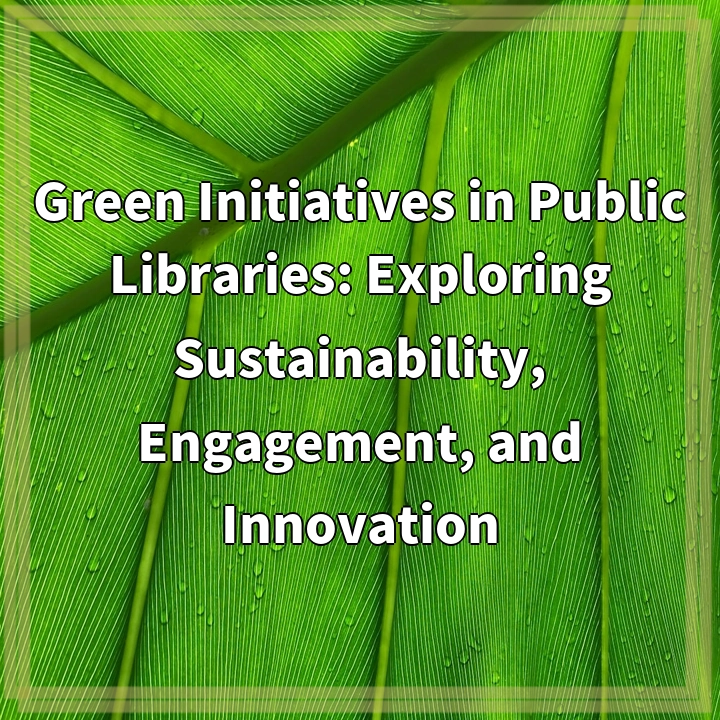
What are Green Initiatives in Public Libraries?
Green initiatives in public libraries refer to the various sustainability efforts implemented by these institutions to reduce their environmental impact and promote eco-friendly practices. These initiatives encompass a wide range of actions, including energy efficiency measures, waste reduction and recycling programs, the use of renewable energy sources, and the promotion of environmental education and awareness within the library and its community.
Real-World Problems Associated with Green Initiatives
While green initiatives in public libraries offer numerous environmental and social benefits, they also face specific challenges and obstacles. Understanding these real-world problems can help libraries overcome them and achieve their sustainability goals more effectively.
1. Limited Financial Resources
One of the primary obstacles for public libraries in implementing green initiatives is the limited financial resources available. Libraries need budget allocations to invest in energy-efficient technologies, recycling infrastructure, and educational programs. The lack of funding can hinder the adoption of these initiatives and slow down progress towards sustainability.
2. Infrastructure Limitations
Many public libraries are housed in older buildings with outdated infrastructure. Retrofitting these structures to improve energy efficiency or incorporate sustainable features can be challenging and costly. Libraries must find creative solutions to work with existing infrastructure limitations while still making meaningful progress towards environmental sustainability.
3. Stakeholder Engagement
Engaging library staff, patrons, and community members in green initiatives is crucial for their success. However, achieving active participation and support from all stakeholders can be difficult. Overcoming resistance to change and fostering a sense of environmental responsibility among staff and users require effective communication, education, and community involvement.
4. Balancing Preservation and Sustainability
Public libraries have a unique mission to preserve cultural heritage and provide access to resources over time. Balancing preservation efforts, which often require the use of energy-intensive technologies, with sustainability goals can be a complex task. Libraries must find innovative ways to minimize their environmental impact while still fulfilling their core functions.
5. Awareness and Education
Promoting sustainable practices and environmental awareness within the library and the broader community requires ongoing education and outreach efforts. Lack of awareness and understanding of the importance of sustainability can inhibit progress. Public libraries should prioritize educational programs, workshops, and partnerships to raise awareness about environmental issues and encourage behavior change.

Potential Solutions for Green Initiatives in Public Libraries
Implementing sustainable practices in public libraries requires addressing the real-world problems associated with these initiatives. Here are some potential solutions to overcome these challenges and promote successful green initiatives:
1. Seek External Funding and Grants
Public libraries can explore external funding opportunities and apply for grants specifically designated for sustainability projects. Collaborating with local environmental organizations, foundations, and government agencies can provide additional financial resources to support green initiatives.
2. Prioritize Green Infrastructure Upgrades
Libraries should prioritize green infrastructure upgrades when planning renovations or consider retrofitting existing buildings. Energy-efficient lighting, HVAC systems, and insulation can significantly reduce energy consumption and costs. Sustainable materials and construction practices can also be incorporated to minimize environmental impact.
3. Engage Staff and Community Members
Creating a culture of sustainability requires active engagement with library staff and community members. Providing training, education, and incentives for staff to adopt eco-friendly practices can foster a sense of ownership and commitment. Engaging patrons through educational programs, workshops, and community events can encourage them to embrace sustainable behaviors.
4. Integrate Sustainability into Collection Development
Libraries can prioritize the acquisition of digital resources and e-books, reducing the need for physical copies and paper consumption. Partnering with publishers and content providers that prioritize sustainability can support the library’s efforts. Additionally, promoting literature and resources on environmental topics can encourage patrons to learn more about sustainability.
5. Collaborate with Local Organizations
Building partnerships with local environmental organizations, schools, and community groups can amplify the impact of green initiatives. By working together, libraries can expand their outreach and collaborate on educational programs, recycling initiatives, and community projects. These collaborations foster a sense of shared responsibility and create a stronger network of support for sustainability.















